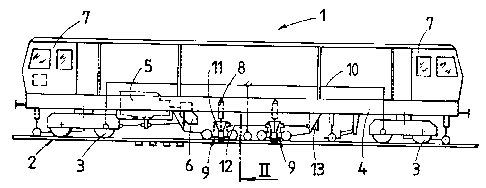Une partie des informations de ce site Web a été fournie par des sources externes. Le gouvernement du Canada n'assume aucune responsabilité concernant la précision, l'actualité ou la fiabilité des informations fournies par les sources externes. Les utilisateurs qui désirent employer cette information devraient consulter directement la source des informations. Le contenu fourni par les sources externes n'est pas assujetti aux exigences sur les langues officielles, la protection des renseignements personnels et l'accessibilité.
L'apparition de différences dans le texte et l'image des Revendications et de l'Abrégé dépend du moment auquel le document est publié. Les textes des Revendications et de l'Abrégé sont affichés :
| (12) Brevet: | (11) CA 2179142 |
|---|---|
| (54) Titre français: | MACHINE POUR LA STABILISATION DE VOIES FERREES |
| (54) Titre anglais: | MACHINE FOR STABILIZING A TRACK |
| Statut: | Périmé et au-delà du délai pour l’annulation |
| (51) Classification internationale des brevets (CIB): |
|
|---|---|
| (72) Inventeurs : |
|
| (73) Titulaires : |
|
| (71) Demandeurs : |
|
| (74) Agent: | RICHES, MCKENZIE & HERBERT LLP |
| (74) Co-agent: | |
| (45) Délivré: | 2005-08-02 |
| (22) Date de dépôt: | 1996-06-14 |
| (41) Mise à la disponibilité du public: | 1996-12-17 |
| Requête d'examen: | 2002-04-10 |
| Licence disponible: | S.O. |
| Cédé au domaine public: | S.O. |
| (25) Langue des documents déposés: | Anglais |
| Traité de coopération en matière de brevets (PCT): | Non |
|---|
| (30) Données de priorité de la demande: | ||||||
|---|---|---|---|---|---|---|
|
Une machine pour stabiliser une voie ferrée composée de rails et de traverses est conçue avec un châssis de machine (4) posée sur des trains de roulement (3) et deux unités de stabilisation (9) reliées au moyen d'agrafes de réglage verticales (8) au châssis de la machine (4), adaptées pour rouler sur la voir ferrée (2) et disposées l'une après l'autre dans le sens longitudinal de la machine. Un générateur de vibrations (11) est associé à chaque unité de stabilisation et il est connecté à un moteur (13) pour générer des vibrations s'étendant perpendiculairement à la direction longitudinale de la machine. Les générateurs de vibrations (11) sont conçus pour produire des vibrations qui sont en opposition de phase les unes par rapport aux autres.
A machine for stabilizing a track composed of rails and sleepers is designed with a machine frame (4) supported on on-track undercarriages (3) and two stabilizing units (9) linked by means of vertical adjustment drives (8) to the machine frame (4), adapted to ride on the track (2) and arranged one following the other in the longitudinal direction of the machine. Associated with each stabilizing unit is a vibration generator (11) connected to a drive (13) to generate vibrations extending perpendicularly to the longitudinal direction of the machine. The vibration generators (11) are designed to generate vibrations which are out-of-phase with one another.
Note : Les revendications sont présentées dans la langue officielle dans laquelle elles ont été soumises.
Note : Les descriptions sont présentées dans la langue officielle dans laquelle elles ont été soumises.

2024-08-01 : Dans le cadre de la transition vers les Brevets de nouvelle génération (BNG), la base de données sur les brevets canadiens (BDBC) contient désormais un Historique d'événement plus détaillé, qui reproduit le Journal des événements de notre nouvelle solution interne.
Veuillez noter que les événements débutant par « Inactive : » se réfèrent à des événements qui ne sont plus utilisés dans notre nouvelle solution interne.
Pour une meilleure compréhension de l'état de la demande ou brevet qui figure sur cette page, la rubrique Mise en garde , et les descriptions de Brevet , Historique d'événement , Taxes périodiques et Historique des paiements devraient être consultées.
| Description | Date |
|---|---|
| Le délai pour l'annulation est expiré | 2015-06-15 |
| Lettre envoyée | 2014-06-16 |
| Inactive : CIB de MCD | 2006-03-12 |
| Accordé par délivrance | 2005-08-02 |
| Inactive : Page couverture publiée | 2005-08-01 |
| Inactive : Taxe finale reçue | 2005-05-18 |
| Préoctroi | 2005-05-18 |
| Un avis d'acceptation est envoyé | 2005-04-28 |
| Un avis d'acceptation est envoyé | 2005-04-28 |
| Lettre envoyée | 2005-04-28 |
| Inactive : Approuvée aux fins d'acceptation (AFA) | 2005-04-05 |
| Modification reçue - modification volontaire | 2004-11-29 |
| Inactive : Dem. de l'examinateur par.30(2) Règles | 2004-07-13 |
| Inactive : Renseign. sur l'état - Complets dès date d'ent. journ. | 2002-05-02 |
| Lettre envoyée | 2002-05-02 |
| Inactive : Dem. traitée sur TS dès date d'ent. journal | 2002-05-02 |
| Exigences pour une requête d'examen - jugée conforme | 2002-04-10 |
| Toutes les exigences pour l'examen - jugée conforme | 2002-04-10 |
| Demande publiée (accessible au public) | 1996-12-17 |
Il n'y a pas d'historique d'abandonnement
Le dernier paiement a été reçu le 2005-04-15
Avis : Si le paiement en totalité n'a pas été reçu au plus tard à la date indiquée, une taxe supplémentaire peut être imposée, soit une des taxes suivantes :
Les taxes sur les brevets sont ajustées au 1er janvier de chaque année. Les montants ci-dessus sont les montants actuels s'ils sont reçus au plus tard le 31 décembre de l'année en cours.
Veuillez vous référer à la page web des
taxes sur les brevets
de l'OPIC pour voir tous les montants actuels des taxes.
Les titulaires actuels et antérieures au dossier sont affichés en ordre alphabétique.
| Titulaires actuels au dossier |
|---|
| FRANZ PLASSER BAHNBAUMASCHINEN-INDUSTRIEGESELLSCHAFT M.B.H. |
| Titulaires antérieures au dossier |
|---|
| BERNHARD LICHTBERGER |
| JOSEF THEURER |